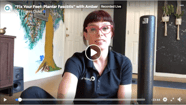We all love starting our day on the right foot! At O2 Fitness we believe that starting your day out powerfully leads to success in every aspect of your life. If your first thought when you stand up out of bed is, “OUCH!” or some expletive version of that, we are here to help! Plantar Fasciitis affects hundreds of thousands of Americans every day. Thanks to the National Academy of Sports Medicine and O2 Fitness personal trainers you can get rid of that pain quickly with some quick and simple strengthening techniques and start your day off on the right foot from now on!
Our Other Resources for Plantar Fasciitis
We all either know someone who has had plantar fasciitis or had the unfortunate experience of it ourselves. We have discussed plantar fasciitis in other posts previously. What causes it. How to assess it. How to stretch and foam roll for it.
Why do I have Plantar Fasciitis?
As discussed, there can be many reasons for plantar fasciitis. Starting to exercise too much too quickly, being overweight, flat feet, or pronation distortion to name a few. The cool thing is that regardless of why you are getting pain, the following strengthening exercises will be beneficial.
Before you can strengthen your foot tissue for plantar fasciitis, you must stretch. Stretching can create immediate relief in irritated or inflamed plantar fascia. Plantar fascia is the tissue on the bottom of the foot. Think of it like saran wrap that helps hold the bones, ligaments, and tendons, together and keeps everyone operating together as a unit. After you have stretched, the following exercises will help you start to rebuild strength in this area and create more long-lasting relief.
Exercises to Strengthen Plantar Fasciitis
The first two strengthening exercises will help increase range of motion in the ankle which has been linked directly to increased risk of plantar fasciitis. The Resisted Ankle Dorsiflexion and Single-Leg Calf Raise are great for bringing support to the plantar fascia when it is irritated. Each exercise should be done for 1-2 sets. Each exercise can be done for between 10 and 15 repetitions. Here is a key for success! Make sure you focus on the eccentric phase of the movement. This is the “lowering” or “lengthening” portion of the movement. What I mean by “focus” is put extra emphasis on slowing down during this portion of the movement. It has been shown that doing more eccentric movements can help rebuild strength and muscle tissue more quickly. Let’s make sure we get the most bang for our buck! Slow down a little to go fast later! Agreed?
Resisted Ankle Dorsiflexion
Anchor a band to an object. Then scoot away from the anchor point. Place your foot into the band. Then begin pulling the band towards your head with your foot only. You should feel a tension in your shin area. You will want to flex the foot towards your head and then let it back down slowly. According the National Academy of Sports Medicine (NASM), we would want to be back at the starting point of the exercise in about 4 seconds. This is also known as a 4 second eccentric movement.
Single Leg Calf Raise or Outward Pointing Toes Calf Raises
For the single leg calf raise, find a step. Let your heel hang off the step. Then press through the ball of your foot to elevate the heel above the ball of the foot. Then lower yourself slowly with a 4 second count. This is the eccentric portion of the movement that we referenced earlier. If this is too difficult try using both feet to start. Get on your step. Turn Both feet outward. Recent research from the International Journal of Sports Physical Therapy suggests that pointing the toes outward will engage the medial calf more. Then press through the balls of your feet. This will elevate your heel and your body above the ball of your foot. Again, slowly lower yourself.
Single Leg Balance and Reach
To perform a single leg balance and reach you will want to have 4-5 cones or 4-5 targets. Preferably 4-5 taller targets. Taller targets will make this drill easier to start. Setup the cones or targets in a semi-circle around either the right or left side of the body. If you are experiencing plantar fasciitis on the right foot orient the cones in a semi-circle around the left leg. Then stand on your right leg. Slowly, reach out and try to touch each target individually without letting the left foot touch the ground. If you need to use a pole, chair, or wall for balance that is okay. By balancing on the right leg, you will create an artificial arch in the right foot. Make sure to press your right foot, big toe into the floor throughout the entire exercise. After touching each target, take a break by performing the exercise on the other leg. Then repeat for the second set to the right leg.
Single Leg Romanian Deadlift with weight
When performing the single leg Romanian deadlift remember that this is a more advanced exercise and can be combined with other movement pattens for higher levels of integration. Other movements like curls, presses, rows, etc. To perform the single leg Romanian deadlift, choose your weighted object. We have chosen a kettle bell. Place the weight near the front foot. Begin by balancing on the right leg. Bend over and grab your weight with your right hand from the right side of your right foot. After you have secured your kettle bell, push the floor away from you and stand up tall. Do not place the left foot on the floor. Then return the kettle bell to the right side of the right foot on the floor and repeat the standing motion. If your balance is not ideal you can use a pole or a chair for balance. Do not go heavy until your balance is sufficient.
There are many options for activation (isolation) and integration (whole body) exercises. For more options you can reach out to an O2 Fitness Personal Trainer. We offer free demo sessions and free assessments to our members in club and to our online community. Find a club near you to get started today. Contact us directly and ask us any questions you might have. We look forward to speaking with you soon!










Leave A Comment